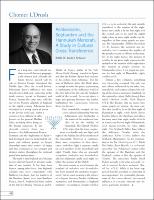Please use this identifier to cite or link to this item:
https://hdl.handle.net/20.500.12202/9095| Title: | Ashkenazim, Sephardim and the Hannukah menorah: A study in cultural cross-transference |
| Authors: | Schacter, Jacob J. |
| Keywords: | Sephardim Ashkenazim Hanukkah Menorah cross-cultural transference multiculturalism |
| Issue Date: | Dec-2006 |
| Publisher: | YU RIETS |
| Citation: | Schacter, J. J. (2006, December). Ashkenazim, Sephardim and the Hannukah menorah: A study in cultural cross-transference. Chavrusa, 41(2), 4-5. |
| Series/Report no.: | Chavrusa;41(2) |
| Abstract: | The truth is that Sephardi and Askenazi Jewries did not flourish in absolute isolation of one another. It has long been known, among other facts, that Sephardi scholars had close connections with Rabbenu Gershom, that the teachers of the Ramban (Spain) were from Southern France, that R. Avraham ha-Yarhi, author of the Sefer ha-Manhig (Provence), and R. Moshe of Coucy, author of the Sefer Mizvot Gadol (Semag), traveled to Spain, and that the Rashba (Spain) had students in his yeshiva from Ashkenaz.1 The life story of Rabbenu Asher (the Rosh) alone is enough to make this point, representing a combination of the Ashkenazi world of the first half of his life and the Sephardi world of the second.2 In recent times, a large and growing literature has further highlighted the connections between these two Jewries.3 |
| Description: | Article / Chomer L’Drush |
| URI: | https://hdl.handle.net/20.500.12202/9095 |
| Appears in Collections: | Bernard Revel Graduate School of Jewish Studies (BRGS): Faculty Publications |
Files in This Item:
| File | Description | Size | Format | |
|---|---|---|---|---|
| Jacob_J_Schacter_Ashkenazim_Sephardim_Chavrusa Dec2006 4-5.pdf | 332.89 kB | Adobe PDF |  View/Open |
This item is licensed under a Creative Commons License

